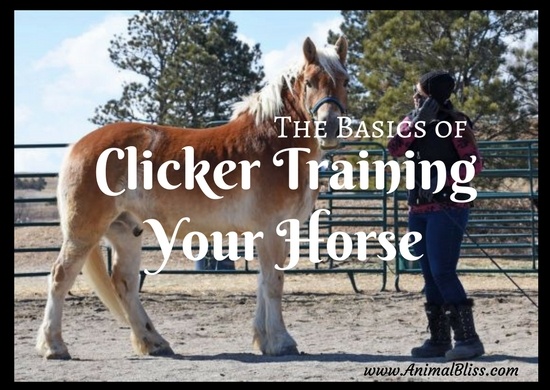Since the domestication of wild horses thousands of years ago, humans have been coming up with new, creative ways in which to train their animals. Historically, horse training has been used for farm work, sport, and transport. Today, training your horse is also necessary for riding, shows, and stunt work.
Positive reinforcement is a reward-based training tool, meaning when an animal performs the desired behavior, typically, food is given as a reward). Even more effective than typical reward training is a more specific positive reinforcement method: clicker training. Clicker training your horse involves using a handheld clicker to signal good behavior and indicates that a treat is on its way. By utilizing the clicker rather than instantly rewarding with food, training is more successful as it is easier to communicate which behavior earned the reward.
Another benefit of clicker training is that it is adaptable. This method can be used in many different ways and is guaranteed to fit into your training style. You can use clicker training in tandem with other training methods to introduce a clear correlation between specific behavior and rewards. This method provides trainers insight into the horse’s level of effort and preferred ways of learning, making it much easier to take training one step at a time.
The Basics of Horse Clicker Training
While clicker training can be used in countless ways, there are some primary methods in which to utilize this helpful training tool:
Capturing
Capturing is often the first and most expected method to use when clicker training your horse. When your horse performs a particular behavior, immediately click and reward. This method introduces them to the concept of the clicker, associating the click with the reward, and creating an understanding of marked behavior.
Shaping
This is the most helpful way to use when clicker training your horse. Shaping is when a trainer builds a behavior in small steps. To do this, determine the final behavior and work toward it through a series of rewarded behaviors. Breaking the task down into smaller actions makes it easier for the horse to follow your direction. Among many other important tasks, shaping can be used to help horses be comfortable with touch and teach behaviors on command such as lifting their feet, lying down, and coming when called.
Shaping with Pressure and Release
This sub-training method of shaping is often paired with clicker training. In using a clicker in this traditional training method, the trainer can most clearly indicate the desired behavior by combining a click with the release of pressure. Also, it allows the trainer to use slight amounts of force to train gently and without the risk of the pressure being perceived as an attack. By introducing a clicker to the pressure and release method, even the slightest movements can be immediately rewarded.
RELATED:
Training Your Horse with Music, Equestrian Training Technique
Luring
Luring is the process of using food to achieve the desired behavior, followed by a click and a treat as a reward. While this method is not ideal for clicker training, it can be effective so long as the horse knows that they cannot have the reward until after the clicker has been clicked. Luring should only be used temporarily to jump start behavior instead of as a primary training method. Treats alone pose too great a distraction and result in less effective training.
Targeting
Targeting is the process of training a horse to touch a specific body part to another object, i.e., their nose to an orange cone. This behavior is taught through capturing and shaping but is helpful in teaching the horse to complete specific tasks like leading, touching intimidating objects, and willingly moving certain body parts. Targeting used to be taught through luring, but clicker training offers less distraction and is more effective.
Molding
This is a method that should only be used with horses that are relaxed and comfortable with being manipulated. In the molding method, the trainer physically shows the horse what they would like them to do by adjusting their body. Once the trainer demonstrates what they want the horse to do, they click and reward. After repeating several times, the horse should start responding on their own. Once the horse begins participating, molding is no longer necessary. Like luring, this method should only be utilized in the beginning.
Conclusion
While there are many ideas on the best methods to train horses, training using positive reinforcement has proven to be one of the most effective techniques. This gentle training method is guaranteed to motivate your horse and increase their willingness to perform. Through clicker training, confidence is built, and learning is accelerated. Clicker training has been proven to be effective in training nervous horses, solving behavioral issues, improving responses, and making grooming easier on both the horse and the trainer. Not only does this training provide more clarity for the animal, but it also bonds the horse to the trainer, reduces their stress level, and helps them retain their learning longer.
~~~~~
“The Basics of Clicker Training Your Horse”
Guest Author: Jayson Goetz Jayson is a writer from Phoenix, Arizona who loves animals and pets! He is a proud owner of a beautiful mare and wants to share the joy of pet and horse ownership with others. He hopes to encourage people to keep their animals happy and healthy year-round.
https://media.defense.gov/2018/Mar/26/2001894767/1923/1175/0/180305-F-II154-0027.JPG
*** Please Share ***
The Basics of Clicker Training Your Horse #Horses #HorseTraining #Equestrian Share on X- 4 Tips for Maintaining Healthy Weight for Your Cat - December 20, 2019
- 8 Amazing Benefits of CBD for Dogs and Other Pets - December 12, 2019
- Kibble or Canned Pet Food? What Should Your Pet Be Eating? - December 9, 2019

